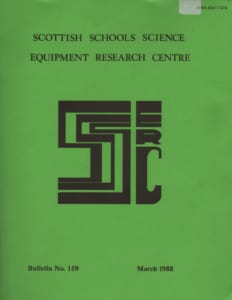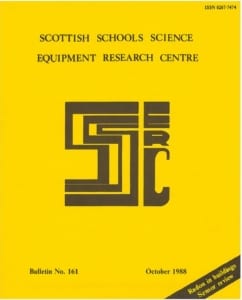The page numbers refer to the pages in the pdf. (The numbers in brackets are those given in the actual bulletin)
3(1) Opinion
Marketable mediocrity
5(3) Introduction
Easter holiday, ASE annual meeting, Surplus offer, No Comment
6(4) CLEAPSE Guides
We have recently received the following new or revised publications from our sister organisation CLEAPSE School Science Service:
6(4) Help with VELA
There are now several, and in the jargon “more friendly” publications to help the user.
7(5) Science and special needs
We promised recently to publish a list of, fairly recent, references on making science more accessible to pupils with special educational needs. We give below a first attempt at such a list:
8(6) lonising radiations
In Bulletin 158 we made reference to a number of documents on ionising radiations which were to be issued at the turn of the year. P11 of these have since been published and issued to Scottish EAs.
8(6) ASE publications: new edition of “Safeguards”
The ASE has recently published a ninth edition of its well known and authoritative safety publication: “Safeguards in the School Laboratory”..
9(7) New primary publication
A new ASE safety document aimed at primary education. This is entitled “Be Safe!”
9(7) Biotechnology
An article on safety in school biotechnology appeared in the January issue of “Education in Science”, No.126. The article provides a useful overview of the subject.
9(7) Electric heating mantles
Possible problems with mantles manufactured by Electrothermal Ltd.
10(8) Gas taps, anti—rotation devices
An accident due to partial unscrewing of a laboratory gas tap from its supply pipe. How to prevent recurrence.
11(9) Stream flow measurement
Brief descriptions are given of a number of simple methods for investigating flow in burns and streams. s a result of field trials, an indication is given of the effectiveness of such methods. Pointers to curricular context and to further reading are provided.
15(13) Conductivity probes
Two alternative designs are given. The special point of interest about both is the simple way in which they discriminate between solutions of varying conductivity.
17(15) Ionising radiations – further notes on implementing the new regulations
Distribution of’ circulars, Disposal of sealed sources, Equipment list
19(17) Surplus Equipment Offers
22(20) Broken Bunsen burners
Recently Kincorth Academy sent us a simple plan for restoring disjointed burners back to full health.
The page numbers refer to the pages in the pdf. (The numbers in brackets are those given in the actual bulletin)
3(1) Introduction
Summer Saturdays, Biotechnology symposium, Readers’ letter 1
4(2) Opinion
SEB Panels’ comments on Bulletin 159
6(4) Continuous recording of velocity
By coupling a precision motor, which is used as a generator, to one of the wheels of’ a dynamics tralley and taking the output signal to a data logger a continuous record of velocity versus time can be obtained.
9(7) The protactinium generator: stoppering the flask
Some of the flasks in our equipment list in Bulletin 159 were reported to us as leaking at the stopper.
10(8) Interfacing Notes
10(8) software standards – minimal, acceptable standards for interfacing software
14(12) interfacing publications: support for training & users – Here are our initial attempts at identifying what is available, on a national basis, to support interfacing for instrumentation and control on the BBC B and Master.
17(15) Bulletin Index —numbers 150 to 159
3(1) Announcement
The future of SSSERC
4(2) Introduction
Biotechnology Symposium, Thanks Nick, Christmas closure, Technical resource support for Standard Grade, Comment
5(3) Radioactive sources – leakage tests
As a requirement of the Ionising Radiations Regulations many schools have now for the first time tested their sealed radioactive sources for leakage.
7(5) Modern instrumentation in biology teaching
The need to use electronic sensors is discussed together with educational arguments on requirements for “transparency” of operation.
11(9) Radon in buildings – a simple detection method
In recent years there has been an increased interest in the subject of natural background radiation. We show a simple method to retect radon.
15(13) A chain reaction – with mousetraps
A collection of twelve or so mousetraps are set and placed in the bottom of’ a large clear plastic tank and a ping-pong ball thrown in.
15(13) Ring main models
Further comments and clarifications.
17(15) Digital multimeters and blown fuses
We have had several reports of fuses blowing in digital multimeters – not just in one or two meters – but in part class sets of meters.
18(16) Electronic sensors
Modern electronic sensors are reviewed and the general structure of sensory instruments is described. Sensors are classified according to physical method of operation. market summary of commercial sensors for educational use is given. There is advice on matching commercial sensors to displays or recorders.
28(26) Screen dumps from ‘Grapher’
The ‘Grapher’ data acquisition software for use with the Unilab Interface has no facility for screen-dumping graphs directly to a dot-matrix printer. A short program in BBC Basic is shown here with suggested custom modification to users’ requirements.
29(17) D.C. amplifier with offset
The circuit described has a gain of 5 and an offset of -2.5 V. It can be used as a general purpose voltage amplifier or as a means of tailoring the standard 0 to 1 V outputs from transducers to the 2.5 V input range of VELA.
29(27) Surplus Equipment Offer
32(30) Trade News
Harris take over INS, Resilient foam, Change of address, Special balance offers
32(30) Notice Board
ASE Annual Meeting
33(31) Opinion
Triumph over the beast






